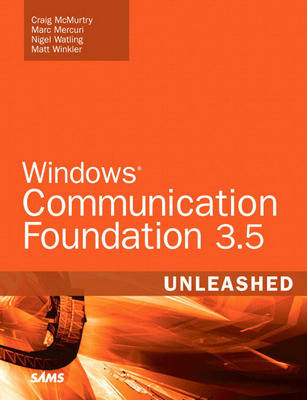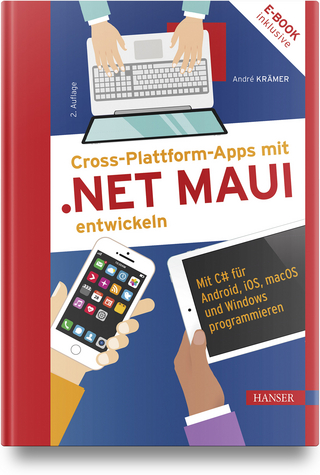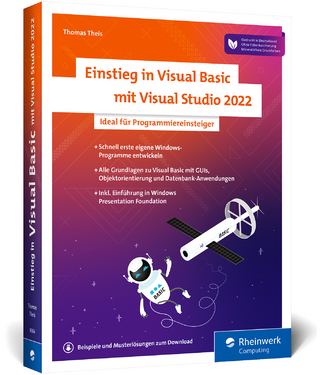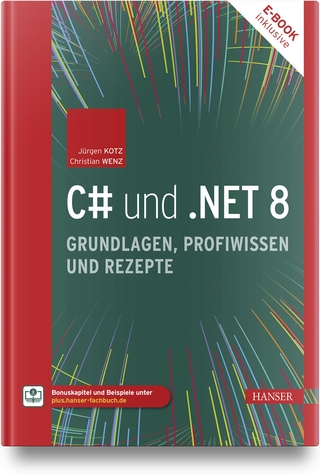
Windows Communication Foundation 3.5 Unleashed
Sams Publishing (Verlag)
978-0-672-33024-7 (ISBN)
- Titel ist leider vergriffen;
keine Neuauflage - Artikel merken
executables from lower-level class libraries.
Windows Communication Foundation 3.5 Unleashed is designed to be the essential resource for software developers and architects working with WCF. The book guides readers through a conceptual understanding of all the facilities of WCF and provides step-by-step guides to applying the technology to practical problems.
As evangelists at Microsoft for WCF, WF, and CardSpace, Craig McMurtry, Marc Mercuri, Nigel Watling, and Matt Winkler are uniquely positioned to write this book. They had access to the development team and to the product as it was being built. Their work with enterprises and outside software vendors has given them unique insight into how others see the software, how they want to apply it, and the challenges they face in doing so.
--Gives you nearly 100 best practices for programming with WCF
--Provides detailed coverage of how to version services that you will not find anywhere else
--Delves into using WCF together with Windows Workflow Foundation (WF) and Windows CardSpace
--Provides detailed coverage of the new high-performance data contract serializer for .NET
--Walks you through creating secure, reliable, transacted messaging, and how to understand the available options
--Introduces you to federated, claims-based security and shows you how to incorporate SAML and WS-Trust security token services into your architecture
--Provides step-by-step instructions for how to customize every aspect of WCF
--Shows you how to add behaviors, communication channels, message encoders, and transports
--Presents options for implementing publish/subscribe solutions
--Gives clear guidance on peer-to-peer communications with WCF
Matt Winkler is a senior Program Manager in Microsoft’s Connected Systems Division, where he focuses on building the visual designer for WF. Previously he was the Technical Evangelist for WF, focusing on driving adoption among software developers around the world. Based in Redmond, Matt spends his non-work time reading more tech books and chasing around his two children.
Part I Introducing the Windows Communication Foundation
Chapter 1 Prerequisites 9
Partial Types ....................................................................................................9
Generics.........................................................................................................10
Nullable Value Types.....................................................................................13
The Lightweight Transaction Manager.........................................................14
Role Providers ...............................................................................................16
Summary .......................................................................................................18
References......................................................................................................19
Chapter 2 The Fundamentals 21
Background ...................................................................................................21
Enter Services ................................................................................................24
Windows Communication Foundation .......................................................26
The Service Model.........................................................................................28
A Software Resource.............................................................................34
Building a Service for Accessing the Resource ....................................36
Using the Service .................................................................................55
Hosting the Service in IIS ....................................................................67
Changing How the Service Communicates ........................................72
Visual Studio 2008 Tool Support ..................................................................75
Summary .......................................................................................................82
References......................................................................................................83
Chapter 3 Data Representation and Durable Services 85
Background ...................................................................................................85
The XmlSerializer and the DataContractSerializer.......................................87
The XML Fetish.............................................................................................91
Building a Service ................................................................................92
Building a Client..................................................................................95
Succumbing to the Urge to Look at XML...........................................95
The Case for the DataContractSerializer .............................................95
Using the DataContractSerializer .................................................................96
Exception Handling ....................................................................................110
Durable Services ..........................................................................................114
Why Durable Services? ......................................................................114
Implementing Durable Services ........................................................115
Summary .....................................................................................................122
References....................................................................................................123
Chapter 4 Sessions, Reliable Sessions, Queues, and Transactions 125
Reliable Sessions..........................................................................................125
Reliable Sessions in Action ................................................................127
Session Management ..................................................................................129
Queued Delivery .........................................................................................130
Enhancements in Windows Vista .....................................................132
Transactions ................................................................................................134
Summary .....................................................................................................143
Part II Introducing the Windows Workflow Foundation
chapter 5 Fundamentals of the Windows Workflow Foundation 147
What Is Windows Workflow Foundation?.................................................147
What Windows Workflow Foundation Is Not ..................................148
Activities......................................................................................................149
Out of the Box Activities ...................................................................151
Creating Custom Activities ...............................................................152
Communicating with Activities ........................................................160
Design Behavior.................................................................................167
Transactions and Compensation.......................................................170
Workflow Models ........................................................................................172
Sequential Workflows ........................................................................175
State Machine Workflows..................................................................183
Custom Root Activities......................................................................184
Workflow Hosting.......................................................................................184
Hosting the Runtime .........................................................................185
Runtime Services................................................................................186
Custom Services.................................................................................196
Rules Engine................................................................................................199
Rules as Conditions ...........................................................................200
The ConditionedActivityGroup Activity...........................................202
Rules as Policy....................................................................................204
Summary .....................................................................................................207
References....................................................................................................207
Chapter 6 Using the Windows Communication Foundation
and the Windows Workflow Foundation Together 209
Consuming Services....................................................................................210
Calling Services in a Custom Activity...............................................210
Using the Send Activity (the 3.5 Approach) .....................................214
Extending the Send Activity..............................................................217
Orchestrating Services.................................................................................219
Exposing Workflows as Services .................................................................220
Hosting Inside a WCF Service (.NET 3.0)..........................................220
Exposing a Workflow as a Service (.NET 3.5)....................................226
Creating a Workflow Service .............................................................233
Context ..............................................................................................234
Patterns of Communication..............................................................237
Summary .....................................................................................................248
References....................................................................................................248
Part III Security
Chapter 7 Security Basics 251
Basic Tasks in Securing Communications ..................................................251
Transport Security and Message Security ...................................................252
Using Transport Security.............................................................................253
Installing Certificates.........................................................................253
Identifying the Certificate the Server Is to Provide ..........................255
Configuring the Identity of the Server .............................................256
Transport Security in Action .............................................................257
Using Message Security...............................................................................263
Impersonation and Authorization..............................................................269
Impersonation.............................................................................................269
Authorization ..............................................................................................272
Reversing the Changes to Windows...........................................................281
Uninstalling the Certificates .............................................................281
Removing the SSL Configuration from IIS .......................................282
Removing the SSL Configuration from HTTP.SYS ............................283
Restoring the Identity of the Server..................................................283
Summary .....................................................................................................283
References....................................................................................................284
Chapter 8 Windows CardSpace, Information Cards, and the Identity Metasystem 285
The Role of Identity ....................................................................................285
Microsoft Passport and Other Identity Solutions ......................................288
The Laws of Identity ...................................................................................290
The Identity Metasystem ............................................................................291
Information Cards and CardSpace .............................................................297
Managing Information Cards .....................................................................299
Architecture, Protocols, and Security .........................................................306
CardSpace and the Enterprise.....................................................................319
New Features in .NET Framework 3.5 ........................................................322
HTTP Support in .NET Framework 3.5 .......................................................324
Summary .....................................................................................................326
References....................................................................................................327
Chapter 9 Securing Applications with Information Cards 329
Developing for the Identity Metasystem....................................................329
Simple Demonstration of CardSpace..........................................................331
Prerequisites for the CardSpace Samples ....................................................332
1) Enable Internet Information Services and ASP.NET 2.0 ...............333
2) Get X.509 Certificates ...................................................................333
3) Import the Certificates into the Certificate Store.........................334
4) Update the Hosts File with DNS Entries to Match the Certificates .........334
5) Internet Information Services Setup .............................................335
6) Certificate Private Key Access .......................................................335
7) HTTP Configuration......................................................................336
Adding Information Cards to a WCF Application.....................................337
Adding Information Cards .........................................................................342
Using a Federation Binding ........................................................................347
Catching Exceptions ...................................................................................348
Processing the Issued Token .......................................................................350
Using the Metadata Resolver ......................................................................351
Adding Information Cards to Browser Applications..................................353
Creating a Managed Card...........................................................................364
Building a Simple Security Token Service ..................................................367
Using CardSpace over HTTP .......................................................................370
Summary .....................................................................................................370
References....................................................................................................370
Chapter 10 Advanced Security 371
Prelude.........................................................................................................371
Securing Resources with Claims .................................................................372
Claims-Based Authorization Versus Role-Based Authorization ........373
Claims-Based Authorization Versus Access Control Lists .................374
Leveraging Claims-Based Security Using XSI .............................................377
Authorizing Access to an Intranet Resource Using
Windows Identity............................................................................377
Improving the Initial Solution ..........................................................384
Adding STSs as the Foundation for Federation.................................391
Reconfiguring the Resource Access Service .......................................405
Reconfiguring the Client ...................................................................408
Experiencing the Power of Federated,
Claims-Based Identity with XSI ......................................................411
Claims-Based Security and Federated Security ...........................................412
Summary .....................................................................................................413
References....................................................................................................414
Part IV Integration and Interoperability
Chapter 11 Legacy Integration 417
COM+ Integration.......................................................................................417
Supported Interfaces ..........................................................................418
Selecting the Hosting Mode ..............................................................419
Using the COM+ Service Model Configuration Tool.................................419
Exposing a COM+ Component as a Windows
Communication Foundation Web Service...............................................421
Referencing in the Client ..................................................................426
Calling a Windows Communication Foundation Service from COM ......428
Building the Service...........................................................................428
Building the Client ............................................................................431
Building the VBScript File .................................................................433
Testing the Solution...........................................................................433
Integrating with MSMQ..............................................................................433
Creating a Windows Communication Foundation Service
That Integrates with MSMQ.....................................................................434
Creating the Request .........................................................................434
Creating the Service...........................................................................435
Creating the Client............................................................................438
Testing................................................................................................442
Summary .....................................................................................................443
Chapter 12 Interoperability 445
Summary .....................................................................................................448
References....................................................................................................448
Part V Extending the Windows Communication Foundation
Chapter 13 Custom Behaviors 451
Extending the Windows Communication Foundation .............................451
Extending the Service Model with Custom Behaviors ..............................452
Declare What Sort of Behavior You Are Providing ...........................453
Attach the Custom Behavior to an Operation or Endpoint.............457
Inform the Windows Communication Foundation of the Custom Behavior ....457
Implementing a Custom Behavior .............................................................458
Declare the Behavior .........................................................................458
Attach.................................................................................................458
Inform................................................................................................459
Implementing Each Type of Custom Behavior..........................................467
Operation Selector .............................................................................467
Parameter Inspector...........................................................................469
Message Formatter .............................................................................471
Message Inspector..............................................................................473
Instance Context Provider.................................................................476
Instance Provider ...............................................................................477
Operation Invokers............................................................................478
Implementing a WSDL Export Extension ..................................................479
Implementation Steps .......................................................................480
Custom Behaviors in Action.......................................................................482
Summary .....................................................................................................483
References....................................................................................................483
Chapter 14 Custom Channels 485
Binding Elements........................................................................................485
Outbound Communication ..............................................................486
Inbound Communication .................................................................487
Channels Have Shapes................................................................................488
Channels Might Be Required to Support Sessions .....................................490
Matching Contracts to Channels ...............................................................490
Communication State Machines ................................................................492
Building Custom Binding Elements ...........................................................493
Understand the Starting Point ..........................................................493
Provide a Custom Binding Element That Supports Outbound Communication ............495
Amend the Custom Binding Element to Support Inbound Communication.....................502
Applying a Custom Binding Element Through Configuration ........................................508
Summary .....................................................................................................511
Chapter 15 Custom Transports 513
Transport Channels.....................................................................................513
Inbound Communication .................................................................514
Outbound Communication ..............................................................514
Message Encoders........................................................................................514
Completing the Stack .................................................................................514
Implementing a Transport Binding Element and an
Encoder Binding Element.........................................................................516
The Scenario ......................................................................................516
The Requirements..............................................................................517
The TcpListener and the TcpClient Classes.......................................517
Implementing Custom Binding Elements to Support an Arbitrary TCP Protocol ...........520
The Configuration .............................................................................520
The Custom Transport Binding Element ..........................................522
The Channel Listener ........................................................................525
The Transport Channel .....................................................................528
The Message Encoder.........................................................................530
Using the Custom Transport Binding Element.................................532
Summary .....................................................................................................532
References....................................................................................................533
Part VI Special Cases
Chapter 16 Publish/Subscribe Systems 537
Publish/Subscribe Using Callback Contracts..............................................538
Publish/Subscribe Using MSMQ Pragmatic Multicasting ..........................544
Publish/Subscribe Using Streaming ............................................................552
The Streamed Transfer Mode.............................................................553
Transmitting a Custom Stream with the Streamed Transfer Mode.......557
Implementing Publish/Subscribe Using the Streamed Transfer Mode and a Custom Stream .......561
Summary .....................................................................................................565
References....................................................................................................566
Chapter 17 Peer Communication 567
Using Structured Data in Peer-to-Peer Applications ..................................567
Leveraging the Windows Peer-to-Peer Networking
Development Platform .............................................................................568
Understanding Windows Peer-to-Peer Networks .......................................569
Using Peer Channel ....................................................................................569
Endpoints...........................................................................................569
Binding ..............................................................................................570
Address...............................................................................................574
Contract .............................................................................................574
Implementation.................................................................................575
Peer Channel in Action ..............................................................................575
Envisaging the Solution ....................................................................575
Designing the Data Structures...........................................................579
Defining the Service Contracts .........................................................581
Implementing the Service Contracts ................................................584
Configuring the Endpoints ...............................................................585
Directing Messages to a Specific Peer................................................587
Custom Peer Name Resolution..........................................................590
Seeing Peer Channel Work ................................................................595
Peer Channel and People Near Me.............................................................598
Summary .....................................................................................................598
References....................................................................................................598
Chapter 18 Representational State Transfer and Plain XML Services 599
Representational State Transfer ..................................................................599
REST Services...............................................................................................600
REST Services and Plain XML .....................................................................600
The Virtues and Limitations of REST Services............................................601
Building REST POX Services with the Windows Communication Foundation ........602
The Address of a REST POX Service Endpoint..................................602
The Binding of a REST POX Service Endpoint..................................602
The Contract of a REST POX Service Endpoint ................................603
Implementation.................................................................................604
A Sample Application ........................................................................604
RSS and ATOM Syndication in .NET Framework 3.5.................................609
JSON ............................................................................................................615
A Sample ASP.NET AJAX+JSON Application .....................................616
Summary .....................................................................................................620
References....................................................................................................620
Part VII The Lifecycle of Windows Communication Foundation Applications
Chapter 19 Manageability 623
Instrumentation and Tools .........................................................................624
The Configuration System and the Configuration Editor................625
The Service Configuration Editor......................................................627
Configurable Auditing of Security Events.........................................633
Message Logging, Activity Tracing, and the Service Trace Viewer .......636
Performance Counters .......................................................................647
WMI Provider ....................................................................................649
Completing the Management Facilities .....................................................658
Summary .....................................................................................................659
Chapter 20 Versioning 661
Versioning Nomenclature...........................................................................662
The Universe of Versioning Problems ........................................................662
Adding a New Operation...................................................................662
Changing an Operation.....................................................................664
Deleting an Operation.......................................................................668
Changing a Binding ..........................................................................669
Deciding to Retire an Endpoint ........................................................669
Changing the Address of a Service Endpoint ...................................670
Centralized Lifecycle Management ............................................................670
Summary .....................................................................................................673
References....................................................................................................673
Part VIII Guidance
Chapter 21 Guidance 677
Adopting the Windows Communication Foundation...............................677
Working with Windows Communication Foundation Addresses.............679
Working with Windows Communication Foundation Bindings ..............681
Working with Windows Communication Foundation Contracts.............684
Working with Structural Contracts ...................................................687
Working with Behavioral Contracts..................................................689
Working with Windows Communication Foundation Services ................691
Ensuring Manageability.....................................................................695
Working with Windows Communication Foundation Clients .................699
Working with Large Amounts of Data .......................................................705
Debugging Windows Communication Foundation Applications .............707
Summary .....................................................................................................708
References....................................................................................................709
| Erscheint lt. Verlag | 15.10.2008 |
|---|---|
| Verlagsort | Indianapolis |
| Sprache | englisch |
| Maße | 181 x 230 mm |
| Gewicht | 1182 g |
| Themenwelt | Informatik ► Programmiersprachen / -werkzeuge ► NET Programmierung |
| ISBN-10 | 0-672-33024-5 / 0672330245 |
| ISBN-13 | 978-0-672-33024-7 / 9780672330247 |
| Zustand | Neuware |
| Haben Sie eine Frage zum Produkt? |
aus dem Bereich


